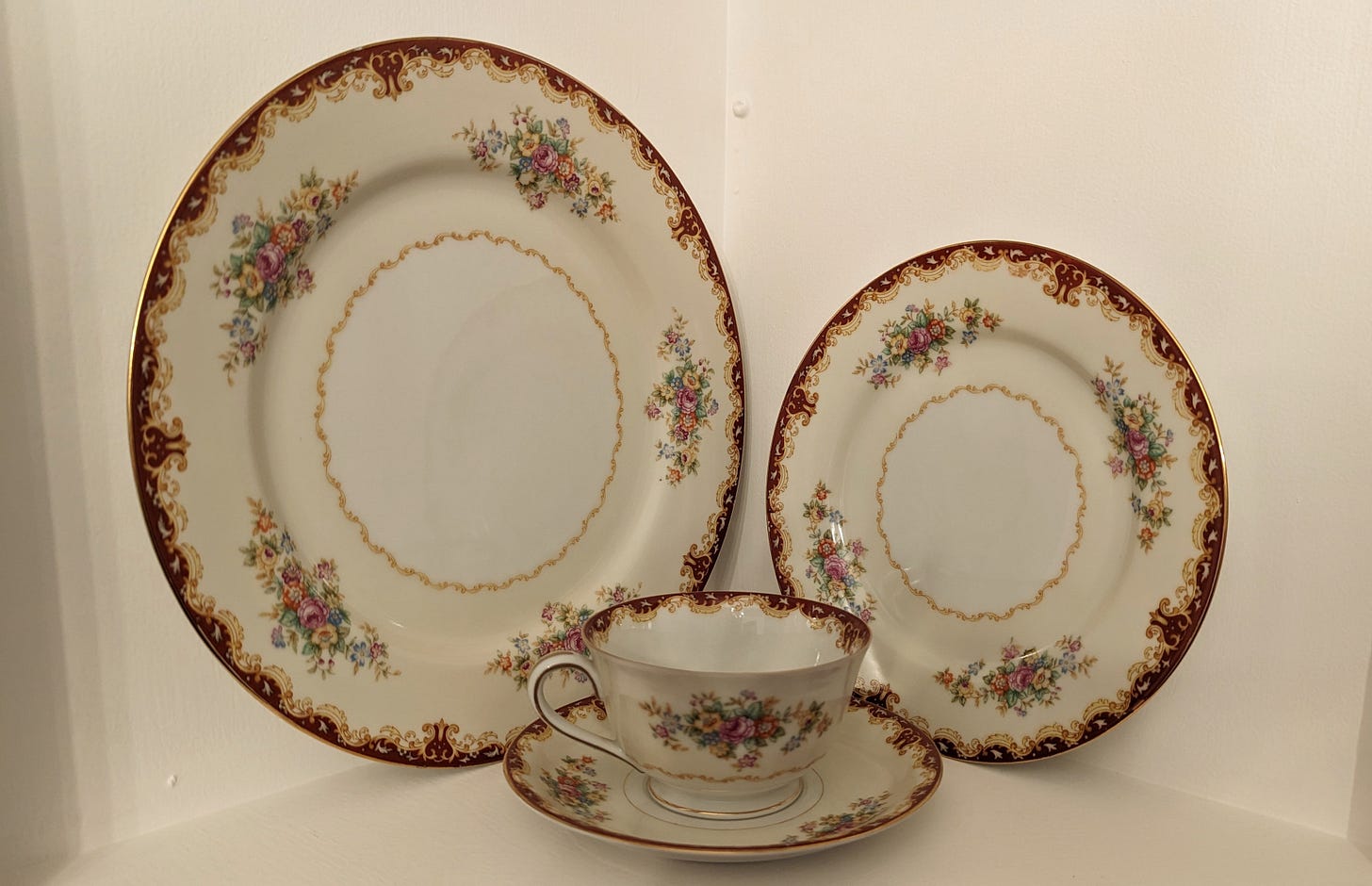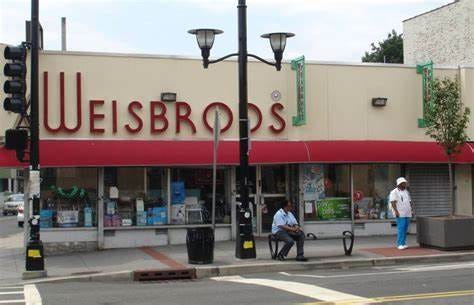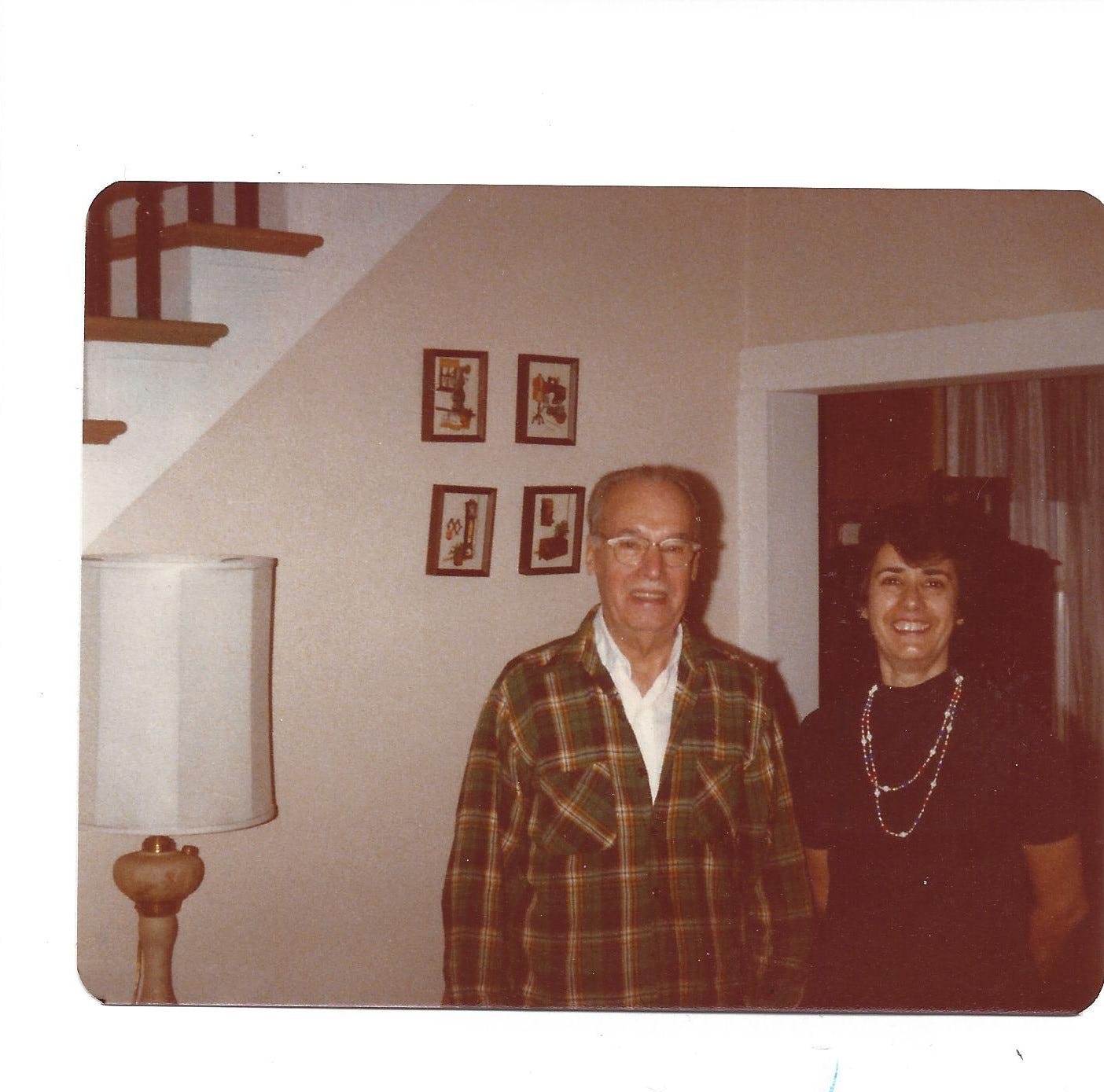Little feet ensconced in shiny black patent leather shoes and white ankle socks, hand reaching for the railing overhead, little me is toiling mightily up the first set of stairs from the street level to the front door of my grandfather’s house in Newark, New Jersey. The rough cement steps are broad and not too steep, and I like the wrought iron railing. It’s the next flight that really gets me - the steep wooden steps painted gun-metal gray, with a wooden hand railing to match. The hand railing is too wide for my little hand to grasp comfortably, and the sharp incline of these steps taxes my breathing and the strength in my legs every single time. I’m relieved to gain the porch and wait for the buzzer to let us in the front door. The family signal is three shrill rings of the old-fashioned doorbell (a black button inside a small brass frame), after which either Grandpa or Aunt Viv presses a similar button on the second floor. This operation produces a long, loud buzz and an even louder clunk as the front door lock releases.
And in we troop, my parents, my brother, and me.
Inside the front door is a high-ceilinged hallway leading toward the back of the first floor. There is a patterned rug runner on the floor and a gleaming mahogany buffet dresser against the wall, with a red model sports car displayed prominently on top. But this quiet hallway is not our destination; this first-floor hallway leads to the flat that Mr. and Mrs. Morton rent from my grandfather. My parents steer us, instead, to the left; to the long, steep, open stairway that will take us up to my grandpa’s flat on the second floor.
On each step, my little shoes tap the rubber stair protectors that are tacked over the carpeting. I like the sound. I like the ornate wooden banister. I like the high ceilings. I like the tall, slightly grubby windows and the “old house” smell of the hall and the stairway. Up the stairs — so many stairs for such little legs — then turn to the right for another five stairs to the dimly lit second floor landing. Finally! We burst into the flat to joyously greet Grandpa and Aunt Viv.

The house at 81 Stuyvesant Avenue was a two-family residence built in 1906 for my great-grandfather, Abraham Lyons. In common with many city houses of the day, each floor contained a complete flat with a front door that opened on an interior hall and a back door that led outside to the sidewalk and the back yard.1
Because Abe’s daughter married a man who was willing to live with his in-laws, this house was the place where my mother and her siblings grew up; three generations together in that second-floor, two-bedroom flat. The four adults occupied the two small bedrooms, and the four kids slept in the third-floor attic. Once the Great Depression hit, that three-generation togetherness was the only way the family kept a roof over its head. My great-grandfather (Abraham) lost his business in downtown Newark, and my grandfather, Norman, while still employed, lost $9002 in the 1929 bank crash.
In the fulness of time, Abe and Luella passed away and the house was inherited by their daughter, my grandmother, Anna; when my grandmother died in 1954, my grandfather inherited. When I came on the scene, my grandmother had been dead for four years already, and I experienced this house only as the home of my beloved “Grandpa Newark” and my Aunt Viv.
Once we’ve made it to the second floor, we enter the dining room with its heavy, ornate dining table and chairs. It is the same dining room table that my mother had played underneath as a toddler in the 1930s. The room is crowded with a mahogany buffet dresser, a built-in glass-front cupboard, and a large free-standing China cabinet. In that China cabinet are pretty things that I desperately want to hold, but, alas, am forbidden to even touch. All I could do was look at them longingly through the glass, occasionally (and futilely) beseeching my mother or my aunt to open the door for me.

The dining room is actually the middle room of the flat, in between the living room at the front and the kitchen at the back.
During my mother’s childhood, the living room was kept closed with pocket doors, only opened on Sundays or holidays for visiting and for the children to take turns showing off their music lessons.3 I can’t imagine a family of eight living without the daily use of that front room, but they did. In my day, the living room was wide open for us to play in, and I enjoyed standing at the low front windows, watching the city traffic go by on the street below. The silvery radiators in front of the windows, with their robust heat, were to be avoided in the winter months, and I was not to touch the pie plates of water that sat on top of those radiators (providing humidity for the room).
There were businesses as well as residences on Stuyvesant Ave, and I vividly remember the neon sign of the hair salon located across the street from Grandpa’s house. I don’t remember the name, but in their windows were large color photographs of trendy 1960s hairstyles. I was very disappointed when my aunt told me that she did not have her hair cut there. Living as I did on a farm, I thought it would be the height of sophistication to simply walk across the street to have one’s hair done.
At the back of Grandpa’s flat, on the far side of the dining room, was the kitchen, but first you had to pass the doorway of the bathroom located off the hallway. The bathroom door was tall and made of wood, with a frosted glass windowpane insert in the top half and the original 1906 wooden doorknobs still in use. As a child, I’d never seen a bathroom so big, with a claw foot tub dating from when the house was built. The room was so large it echoed, and it seemed like a very long walk to the black and white toilet at the far end.
Of course, the kitchen at the back of the flat was the heart of family life, and I wish I had a picture to show you the deep sink cabinet with grooved drain board, the built-in plate and utensil cupboard, the walk-in pantry, the linoleum floor, and the kitchen table with a vinyl tablecloth. I remember wrinkling my nose when sipping water drawn from the kitchen tap. “City water,” my mother would remind me, because at our home in rural New Jersey, we had a well that piped cold, fresh, perfectly clear water into our little house.
Places to play at Grandpa’s were limited to the living room, so we brought coloring books, etc. with us. We were not allowed to walk down Stuyvesant Ave. without an adult until we were much older, and Grandpa’s back yard, angled sharply up the hill, was absolutely no use as a children’s play area. The back stairs were also not a play area because they were winding, narrow, and very, very steep. On one occasion I remember my grandfather taking us down those back steps to the dusty cellar to play on the old ping pong table. But our non-existent ping pong skills soon had the ball ricocheting wildly off the walls and the ceilings. Grandpa never tried that experiment again.
Generally, Aunt Viv would take us on a walk after Sunday afternoon dinner to the corner of South Orange Avenue, a couple of long city blocks from Grandpa’s house. As I look back now, I think Viv may have been eager for the walk in order to leave the dishes for my mother and grandfather to do. Whatever the reason, my brother and I were grateful to get out, stretch our legs, and see a little bit of the city. For a treat, we’d window shop in the drug store on the corner (it’s still there!), and maybe get a candy bar too.
I always left Grandpa Newark’s house for the long drive home with regret, always looking forward to the next visit. The memories of that special house have stayed with me when many others have faded through the years. In the words of the author known as “Miss Read,” I was a fortunate grandchild.4
Ah … and eventually I grew old enough to not be out of breath at the top of those dreaded front steps.
*Yes, I know “slobbing down memory lane” isn’t a valid grammatical phrase, but it should be. Thanks to author Anton Myrer for including it in his book The Last Convertible.
The house at 81 Stuyvesant Ave is still standing and has been under the same ownership since 1986. The open front porch was enclosed sometime after my grandfather sold the house, but the deadly stairs up from the street are still there. A recent internet property search labels the property as a single-family home, so I’m not sure if the current configuration is as it was originally built (two-family).
The equivalent of some $16,000.00 in today’s economy! My grandfather had grown up as part of the “working poor” in England, and he was the most frugal person I’ve ever known. But he also didn’t hesitate to dip into his savings to help his extended family when necessary. He financially supported his elder sister so she could live independently in her final years, and he paid the funeral and burial expenses for his younger sister when she died in 1946. He also paid the majority of the cost of my orthodontia in 1972.
In keeping with the custom of the time, the front living room is also where the body of a deceased family member would be laid out in a casket for visitation. My mother experienced three such times in her life: her grandfather in 1940, her grandmother in 1948, and her mother in 1954. According to my mother, someone had to sit with the body at all times.
Grandpa sold the house in 1978 or 1979, moving briefly with Aunt Viv to an apartment in Verona, New Jersey. But it became unsafe to leave him home alone while Viv was at work all day, so Grandpa moved to Lock Haven, Pennsylvania, first to live with my mother in her home and then into a nursing home. He died in 1982 at the age of 89, having lived for more than 60 years at 81 Stuyvesant Ave. in the historic Vailsburg section of Newark, New Jersey.







It’s incredible how detailed your memory is! I also like how you use the present tense to draw us by the hand through the whole house. It’s like we readers become children alongside you— so interesting.
Such an evocative description of the house you knew so well. ´In that China cabinet are pretty things that I desperately want to hold, but, alas, am forbidden to even touch.’ I remember being fascinated by the china cabinets in my grandparents’ houses.
Lovely!